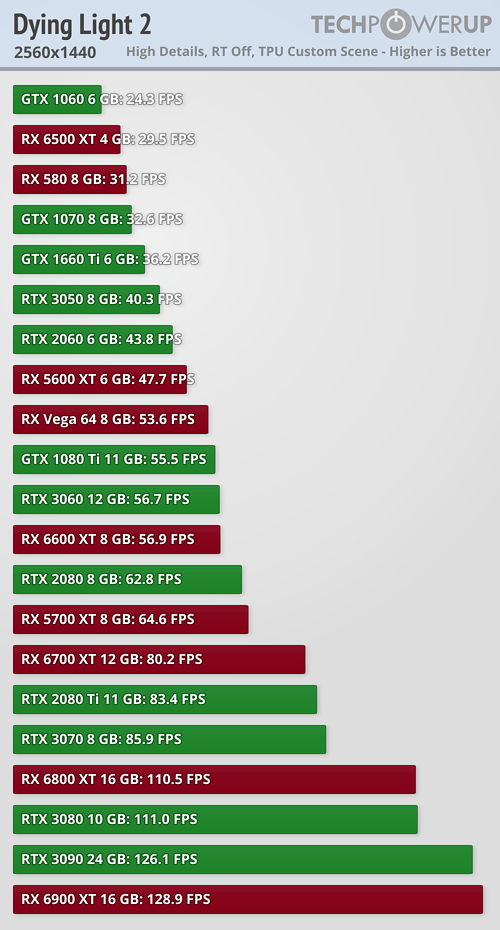 80
80
Dying Light 2 Benchmark Test & Performance Analysis Review
Ray Tracing Performance »Test System
| Test System | |
|---|---|
| Processor: | AMD Ryzen 7 5800X, 8c/16t, up to 4.7 GHz (Zen 3, 32 MB Cache) |
| Motherboard: | EVGA X570 DARK BIOS 1.03 |
| Resizable BAR: | Enabled on all supported AMD & NVIDIA cards |
| Memory: | Thermaltake TOUGHRAM, 16 GB DDR4 @ 4000 MHz 19-23-23-42 1T Infinity Fabric @ 2000 MHz (1:1) |
| Cooling: | Cooler Master MasterLiquid ML240L V2 240 mm AIO |
| Storage: | Neo Forza NFP065 2 TB M.2 NVMe SSD |
| Power Supply: | Seasonic Prime Ultra Titanium 850 W |
| Case: | darkFlash DLZ31 Mesh |
| Operating System: | Windows 10 Professional 64-bit Version 20H2 (October 2020 Update) |
| Drivers: | AMD: 22.2.1 Beta NVIDIA: 511.65 WHQL |
We tested the public release version of Dying Light 2, including the 1.0.3 patch, not a press preview version. Both AMD and NVIDIA have released game-ready drivers for the game, which we used.
Graphics Memory Usage

In a first VRAM test, we're checking the memory usage of the various renderers, all at the same details setting. Only ray tracing was activated on top for a single run. Wow!

AMD vs. NVIDIA VRAM usage shows that AMD graphics cards typically use around 800 MB of additional memory.
Renderer Performance



Next, I benched the renderer options with a selection of graphics cards, at Highest Settings, again with RT disabled.
Surprisingly, DirectX 11 comes out on top, in almost every scenario, but the differences are small.
GPU Performance



FPS Analysis
In this section, we're comparing each card's performance to the average FPS measured in our graphics card reviews, which is based on a mix of 22 games and should provide a realistic average covering a wide range of APIs, engines, and genres.
Feb 19th, 2025 09:23 EST
change timezone
Latest GPU Drivers
New Forum Posts
- Issues with clock speed not increasing (19)
- Msi 5090 DOA? (24)
- 12400f and Patriot 2x8 gb 3600 cl17 max possible OC (6)
- Zotac 5090 Solid disabled ROPs (1)
- Hynix A or M die for "futureproofed" AM5 build? (80)
- It's happening again, melting 12v high pwr connectors (753)
- Microcenter GPU Stock status (11)
- Tomb Raider IV-VI Remastered Discussion (46)
- intel 1700 with high speed ram,memory (4)
- What's your latest tech purchase? (23196)
Popular Reviews
- Gigabyte GeForce RTX 5090 Gaming OC Review
- Ducky One X Inductive Keyboard Review
- WD Black SN7100 2 TB Review - The New Best SSD
- AMD Ryzen 7 9800X3D Review - The Best Gaming Processor
- AVerMedia X'Tra Go GC515 Review
- Kingdom Come Deliverance II Performance Benchmark Review - 35 GPUs Tested
- NVIDIA GeForce RTX 5080 Founders Edition Review
- MSI MAG Z890 Tomahawk Wi-Fi Review
- UGREEN 9-in-1 Steam Deck Docking Station Review
- Gigabyte GeForce RTX 5080 Gaming OC Review
Controversial News Posts
- AMD Radeon 9070 XT Rumored to Outpace RTX 5070 Ti by Almost 15% (301)
- AMD is Taking Time with Radeon RX 9000 to Optimize Software and FSR 4 (256)
- AMD Plans Aggressive Price Competition with Radeon RX 9000 Series (244)
- Edward Snowden Lashes Out at NVIDIA Over GeForce RTX 50 Pricing And Value (241)
- AMD Denies Radeon RX 9070 XT $899 USD Starting Price Point Rumors (239)
- AMD Radeon RX 9070 and 9070 XT Listed On Amazon - One Buyer Snags a Unit (232)
- New Leak Reveals NVIDIA RTX 5080 Is Slower Than RTX 4090 (215)
- AMD's Radeon RX 9070 Launch Faces Pricing Hurdles (175)